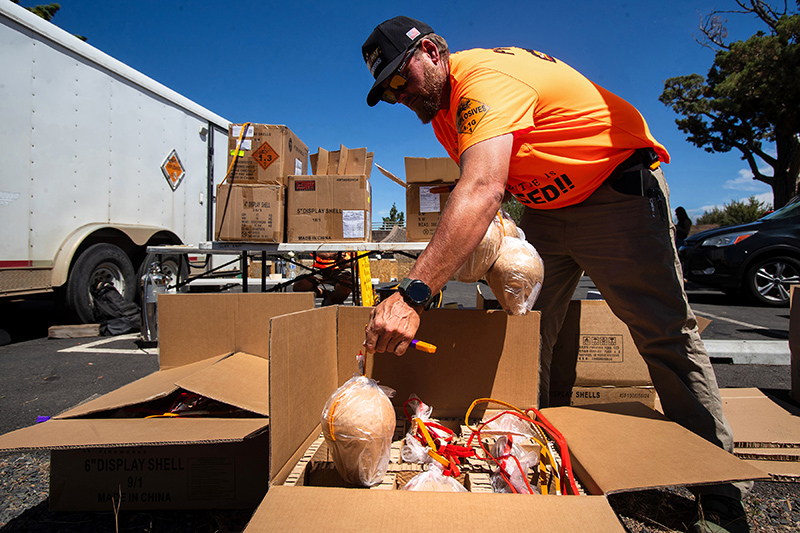Smith Rock makes Newsweek in 1993
Published 12:00 am Sunday, July 22, 2018
Compiled by Don Hoiness from archived copies of The Bulletin at Deschutes County Historical Society.
100 YEARS AGO
For the week ending
July 21, 1918
Semper fidelis
“Semper Fidelis” (Always Faithful) is the motto of the United States Marine Corps, but the popular slogan of the corps is “First to Fight.” For it must be said that the Marines are almost always in some sort of shindig in an out-of-the-way corner of the globe.
They are always ready for instant action and in any sort of work that is required. They have performed notable service in Egypt, Algiers, Tripoli, Mexico, China, Japan, Korea, Cuba, Puerto Rico, Panama, Nicaragua, Santo Domingo, Formosa, Sumatra, Hawaii, Samoa, Guam, Alaska, the Philippines and Haiti. But they insist always that they are not sailors — they are soldiers. And their claim to military distinction is creditably sustained at this moment where thousands of these Marines are serving under General Pershing. The casualty lists testify to their valor, the shattered legions of the prize German “shock troops” prove their military skill and their endurance, fortitude, courage and clean and healthy bodies indicate their true Americanism. Semper Fidelis — always faithful to liberty, democracy, their country and the honored traditions of their corps, they “are proud to bear the title of United States Marines.”
6,000 Yanks per mile facing the Germans in allied drive
Chief of Staff Peyton C. March announced this morning that the American divisions which have been engaged on the more important front of this offensive included the 1st, 2nd, 3rd and 4th regulars and the 28th National Guard Divisions. (The 26th is the New England Division and the 28th the Pennsylvania.) The 42nd National Guard, known as the Rainbow Division and which includes men from 27 states, is on the right flank in Champagne. (This involves the field ambulance unit from La Grande.)
General March announced that the maximum penetration of the Franco-Americans was 10 miles, and that nearly 187,000 Yanks were engaged in the actual fighting along the front. This would indicate that there were over 6,000 Americans to the mile facing the German army and very few French.
An estimated 1.2 million Americans are now overseas.
75 YEARS AGO
For the week ending
July 21, 1943
All-American Air Armada bombs Rome; Italian defense in Sicily ‘cracking up’
An all-American fleet of bombers and fighters raided Rome for the first time in history today, concentrating on railway and aviation facilities of the ancient city.
The first raid lasted two and one-half hours, from the time the first bomb hit the San Lorenzo rail yards until the last one crashed in the Ciampino airdrome sector.
The first flight of fortresses blasted the San Lorenzo marshaling yards, four miles from Vatican City, inaugurating precision bombing by daylight of the Italian capital.
They were followed in by flight after flight of raiders in a 100 percent American show.
Teamed with the four-motored planes of the northwest African air force were bombers of the Middle East command, as well as medium bombers and fighters.
The long planned and carefully executed raid on Rome was aimed exclusively at military targets. It was carried out by select crews, many of the men familiar with Rome first hand, schooled to hit the target and see that no explosives touched the Vatican or other non-military objectives.
All the targets were at least four miles from Vatican City, it was announced officially.
Forty-five minutes after the first wave hit San Lorenzo, another swept over.
Just as the big bombers completed their assault on the yards, the first of the medium bombers began hitting the Littorio marshaling yards.
The fortresses of the northwest African air force flew unescorted to send the first bombs crashing on Rome, headquarters of the fascist party and prime military target despite all its historic shrines.
Leaflets dropped over Rome explain purpose of bombing
Leaflets dropped by allied planes on Rome during today’s raid told the Italian people that the bombers would aim solely at military objectives, war industries, military installations and airdromes.
The text of the leaflets:
“Citizens of Rome:
“You already have been warned that military objectives in the vicinity of Rome are liable to be bombed by the allied air force.
“When this occurs, the fascist government, who consistently conceals news about the war, will say that we are trying to destroy cultural monuments which are the joy, not only of Rome, but of the civilized world.
“It is possible, moreover, that in order to lend plausibility to their lying statement, the fascist government or their German accomplices will themselves arrange that bombs should be dropped on the center of Rome, or even on Vatican City.
“We leave it to your intelligence to decide whether or not we should waste our efforts on targets whose destruction is useless for our aims.
“We have declared and we repeat that we shall be aiming at military objectives, war industries, military installations and airdromes, all of which work entirely in the interests of the Germans. These targets have been carefully chosen and our pilots have been especially trained in precision bombing.
“It is possible, however, when bombing military objectives entirely to avoid destruction of civilian buildings. It is our intention to limit these destructions to a minimum. Our raid will take place during the day so you will be able to see for yourselves whether our statement is true.”
50 YEARS AGO
For the week ending
July 21, 1968
Horse-era gear collection donated to Pioneer Museum — by Ila Grant Hopper
If the Central Oregon Museum were to be as large as the Cow Palace, there would be plenty of room to display all of Dean Hollinshead’s buggies, sleighs, wagons and various paraphernalia from his days as a rangeland cowboy and two-team freighter. But the building at the corner of Greenwood and Harriman is considerably smaller than that. Dean is donating a representative exhibit from his large collection of horse era gear.
The collection is housed in a “hobby house” at Timberlane Ranch on Jones Road, one of several buildings on the 30-acre tract where Dean and his wife, Lily, make their home.
Augmenting Dean’s collection are numerous items left with him by friends for safe keeping. These include the branding irons which once identified the horse herds of Reuben Long, Fort Rock rancher and author, president of the Deschutes Pioneers Association. There are 72 irons in the collection. The procedure for building a range empire was to buy competitor’s irons — and with the transfer of the registered horse brand went all the horses wearing it.
Otis Dean Hollinshead came to the Central Oregon country with his father in 1898 when he was a year old. The family settled on a 160-acre homestead along with his brothers William and Cecil.
Dean worked as a cowboy on various ranches in his youth, and in 1917, made the transition to the motor age and bought his first Model T Ford. The next year he and his brothers went into the trucking business, which they continued for many years.
Dean operated a passenger stage from Bend to Klamath Falls for four years in the 20s, and later had the mail contract from Bend to Lakeview for 12 years. He operated a freight line between the two points until it was sold in 1939 to Bend-Portland Truck Service. Then the brothers were in the logging business until 1956.
Dean and Lily are active in the Rim Rock Riders, and keep nine head of Tennessee walking horses at the ranch. Their locally famous palomino, Mac, appeared in several local stage shows and in a number of movies filmed in the Central Oregon area. He died two years ago at the age of 25.
Recalling his youth, Hollinshead reminisced that his father “never had much money, and never owed any, either. We had a wonderful life.”
The Central Oregon Museum would be incomplete, old-timers agree, without some of the mementos of Dean’s days as a cowboy and freighter.
25 YEARS AGO
For the week ending
July 21, 1993
Smith Rock climbs to spotlight
Terrebonne rock climber Bill Soule and his favorite haunt, Smith Rock State Park, are featured on the current cover of Newsweek magazine.
All it took to make the cover of the national publication was three days of shooting by freelance photographer Ted Wood over the July Fourth weekend. That and a soft spot in the editor’s heart for Smith Rock.
The cover photograph shows Soule hoisting himself up a reddish-colored rock wall.
The shot illustrates a lifestyle article entitled, “On the Edge.” The article focuses on such outdoor recreational activities as sky surfing, bungee jumping and whitewater rafting.
Maynard Parker, the magazine’s editor, was responsible for putting the local landmark on the cover.
Parker based his suggestion on first-hand knowledge.
A Portland native, he vacations annually at Black Butte Ranch. Last year he spent a day at Smith Rock taking climbing lessons from Soule, who later guided the editor and his wife on an ascent up Mount Washington.
“We went in at the day’s first light to shoot, then we’d sleep under the rocks like lizards during the middle of the day, then shoot again in the evenings. The cover shot came early on the third day of shooting, right as the sun was hitting the rock.”
Soule, who lives on the outskirts of the park, has been climbing its massive, red-rock citadels for 17 years.
“I’m kind of psyched about the photo,” he said. “It’s fun to see.
“I’m glad it doesn’t show me doing something stupid. The shot just shows me climbing. I think it’s neat.”
Bike helmets soon to be law
Oregon children and their parents have a year to get ready for a new law requiring children to wear helmets when they ride their bicycles if they are under age 16.
The new law will take effect July 1, 1994. It sets a $25 fine that would be waived for a first offense after a child gets a helmet.
The sponsor, Sen. Ron Cease, said few children wear helmets now “but if they are required to, they will.”
“We’re not trying to be punitive,” he said. “We want them to wear helmets.”
A study done in Seattle concluded that bicycle helmets substantially reduce the risk of serious brain injuries in bicycling accidents.








